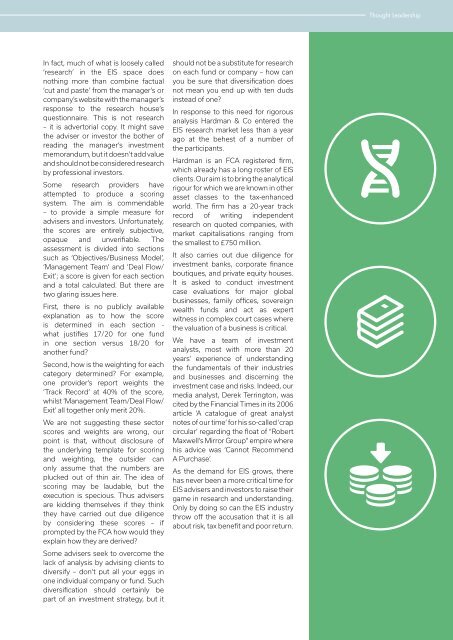2fnoNyY
2fnoNyY
2fnoNyY
You also want an ePaper? Increase the reach of your titles
YUMPU automatically turns print PDFs into web optimized ePapers that Google loves.
Thought Leadership<br />
In fact, much of what is loosely called<br />
‘research’ in the EIS space does<br />
nothing more than combine factual<br />
‘cut and paste’ from the manager’s or<br />
company’s website with the manager’s<br />
response to the research house’s<br />
questionnaire. This is not research<br />
– it is advertorial copy. It might save<br />
the adviser or investor the bother of<br />
reading the manager’s investment<br />
memorandum, but it doesn’t add value<br />
and should not be considered research<br />
by professional investors.<br />
Some research providers have<br />
attempted to produce a scoring<br />
system. The aim is commendable<br />
– to provide a simple measure for<br />
advisers and investors. Unfortunately,<br />
the scores are entirely subjective,<br />
opaque and unverifiable. The<br />
assessment is divided into sections<br />
such as ‘Objectives/Business Model’,<br />
‘Management Team’ and ‘Deal Flow/<br />
Exit’; a score is given for each section<br />
and a total calculated. But there are<br />
two glaring issues here.<br />
First, there is no publicly available<br />
explanation as to how the score<br />
is determined in each section -<br />
what justifies 17/20 for one fund<br />
in one section versus 18/20 for<br />
another fund?<br />
Second, how is the weighting for each<br />
category determined? For example,<br />
one provider’s report weights the<br />
‘Track Record’ at 40% of the score,<br />
whilst ‘Management Team/Deal Flow/<br />
Exit’ all together only merit 20%.<br />
We are not suggesting these sector<br />
scores and weights are wrong, our<br />
point is that, without disclosure of<br />
the underlying template for scoring<br />
and weighting, the outsider can<br />
only assume that the numbers are<br />
plucked out of thin air. The idea of<br />
scoring may be laudable, but the<br />
execution is specious. Thus advisers<br />
are kidding themselves if they think<br />
they have carried out due diligence<br />
by considering these scores – if<br />
prompted by the FCA how would they<br />
explain how they are derived?<br />
Some advisers seek to overcome the<br />
lack of analysis by advising clients to<br />
diversify – don’t put all your eggs in<br />
one individual company or fund. Such<br />
diversification should certainly be<br />
part of an investment strategy, but it<br />
should not be a substitute for research<br />
on each fund or company – how can<br />
you be sure that diversification does<br />
not mean you end up with ten duds<br />
instead of one?<br />
In response to this need for rigorous<br />
analysis Hardman & Co entered the<br />
EIS research market less than a year<br />
ago at the behest of a number of<br />
the participants.<br />
Hardman is an FCA registered firm,<br />
which already has a long roster of EIS<br />
clients. Our aim is to bring the analytical<br />
rigour for which we are known in other<br />
asset classes to the tax-enhanced<br />
world. The firm has a 20-year track<br />
record of writing independent<br />
research on quoted companies, with<br />
market capitalisations ranging from<br />
the smallest to £750 million.<br />
It also carries out due diligence for<br />
investment banks, corporate finance<br />
boutiques, and private equity houses.<br />
It is asked to conduct investment<br />
case evaluations for major global<br />
businesses, family offices, sovereign<br />
wealth funds and act as expert<br />
witness in complex court cases where<br />
the valuation of a business is critical.<br />
We have a team of investment<br />
analysts, most with more than 20<br />
years’ experience of understanding<br />
the fundamentals of their industries<br />
and businesses and discerning the<br />
investment case and risks. Indeed, our<br />
media analyst, Derek Terrington, was<br />
cited by the Financial Times in its 2006<br />
article ‘A catalogue of great analyst<br />
notes of our time’ for his so-called ‘crap<br />
circular’ regarding the float of “Robert<br />
Maxwell’s Mirror Group” empire where<br />
his advice was ‘Cannot Recommend<br />
A Purchase’.<br />
As the demand for EIS grows, there<br />
has never been a more critical time for<br />
EIS advisers and investors to raise their<br />
game in research and understanding.<br />
Only by doing so can the EIS industry<br />
throw off the accusation that it is all<br />
about risk, tax benefit and poor return.


